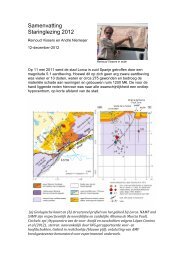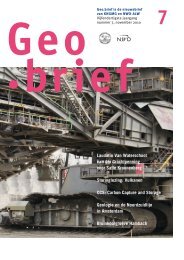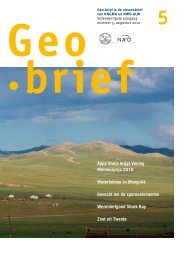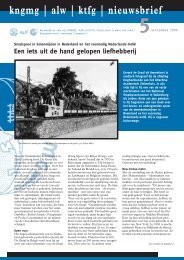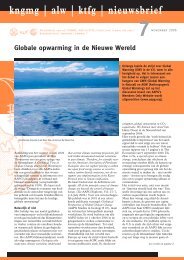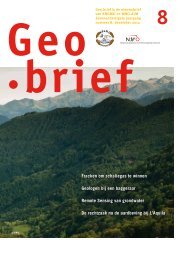Create successful ePaper yourself
Turn your PDF publications into a flip-book with our unique Google optimized e-Paper software.
Shaft V and the sieving house of the Steenkolen Maatschappij Poeloe Laoet, on the island Poeloe Laoet, off the coast of Borneo. The mines were taken<br />
over by ‘het Gouvernement’ in 1913 and closed in 1931 (courtesy of Gerard de Graaf).<br />
colonial past should be returned. The –<br />
largely diplomatic – fight was concluded<br />
in favour of the Republik, owing to strong<br />
pressure from outside, especially the<br />
USA.<br />
What did we leave behind, after nearly a<br />
century of geological and mine engineering<br />
efforts?<br />
- A large amount of geological reporting,<br />
maps, reports, samples, analyses<br />
available in Bandung, but no qualified<br />
Indonesian geologists, since the Dutch<br />
had failed to provide the scientific<br />
education.<br />
- The geological map of Indonesia. Some<br />
areas were mapped in more detail than<br />
others, but by and large some 80% of<br />
the land area was covered. The white<br />
spots on the map were parts of Sulawesi<br />
and most of Irian Jaya.<br />
- A synthesis of the geology made by Rein<br />
van Bemmelen (1904-1983). He had<br />
been requested in 1946 to compile all<br />
the knowledge gathered in the previous<br />
hundred years. He settled in The Hague<br />
and performed this herculean task in<br />
the relative short time of two years.<br />
The result was the magistral book ‘The<br />
geology of Indonesia’; a separate volume<br />
on the geology and a thinner one<br />
on the minerals. Lots of illustrations<br />
were inserted in the text and in a special<br />
folder. The book was printed in<br />
1949 and reprinted in 1970. It is the<br />
strongest connecting element between<br />
16 Geo.brief december 2010<br />
the old, Dutch generation and the new<br />
upcoming Indonesian geologists.<br />
- A once flourishing, but now heavily<br />
damaged oil industry that could relatively<br />
quickly be repaired. The tin and<br />
coal production could be re-established<br />
and would be a solid source of income<br />
for the young republic.<br />
Also the Dutch left behind the memory<br />
of two world-famous scientists whose<br />
reputations are truly international:<br />
- E. Dubois (1858-1940), the first to<br />
find, in 1891, in Trinil, Central Java,<br />
fossil remains of what he named Pithecanthropus<br />
erectus or ‘the upright apeman’.<br />
This caused a real shock in the<br />
scientific world. The missing link<br />
between Man and Ape was there.<br />
- F.A. Vening Meinesz (1887-1966), who<br />
discovered, with a self-designed and<br />
greatly improved gravimeter, by measurements<br />
performed in a submarine of the<br />
Dutch Navy, a line of extra-ordinarily<br />
large negative gravity anomalies, roughly<br />
coinciding with the deep sea troughs<br />
that accompany the island arcs on the<br />
ocean side.<br />
Another legacy was the hidden treasure in<br />
New Guinea, now Provincie Papua, in the<br />
form of one of the world’s largest copper/<br />
molybdene/gold deposits in the Carstensz<br />
Mountains. This was discovered in 1936<br />
by the Dutch oil geologist Jacques Dozy<br />
during an alpinist type of expedition<br />
together with the son of Colijn (Dutch<br />
Prime Minister) and aviator Wissel, after<br />
whom the Wissel Lakes have been<br />
named. These gigantic deposits are now<br />
being mined by an American company,<br />
Freeport. At the time of discovery the<br />
economic value was not realised: “We<br />
might as well have found these ores on<br />
the Moon”, writes Dozy.<br />
Very few Dutch geologists of the previous<br />
regime stayed in Indonesia, but what did<br />
go on was the exploration for oil and gas,<br />
carried out by a multitude of geologists<br />
and geophysicists of many companies<br />
and nationalities, including Royal Dutch/<br />
Shell which did participate but was<br />
unsuccessful.<br />
Today Indonesia has well educated geologists,<br />
as exemplified by the late John<br />
Katili (educated in Bandung), nestor of<br />
this new generation, an excellent geologist,<br />
known and respected well outside<br />
his own country. The recent geological<br />
publications by Indonesian geologists<br />
show how well the modern theories like<br />
Plate Tectonics fit in the Indonesian<br />
archipelago. And productive co-operation<br />
with foreign scientists is exemplified by<br />
the superb publication of ‘Tectonics of<br />
the Indonesian Region’ by Warren Hamilton<br />
together with the Geological Society<br />
of Indonesia and several other institutes.<br />
Peter de Ruiter



